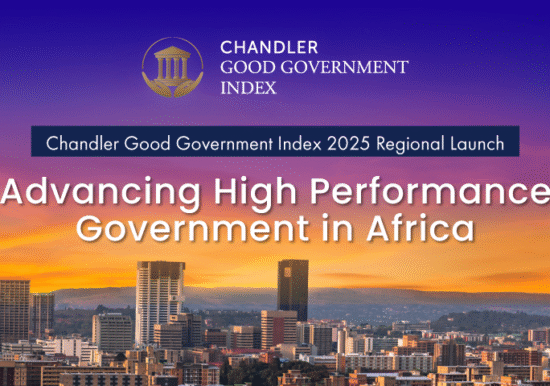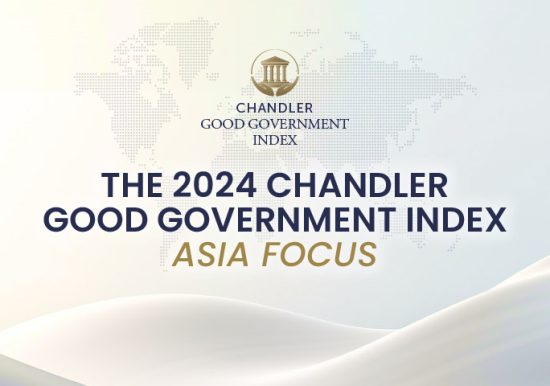
Five Years On—What Does ‘Good’ Government Look Like?
The Chandler Good Government Index (CGGI) launched in 2021 amid a world still reeling from the grip of a global pandemic. As governments―ready or not―raced to protect lives and secure livelihoods, the CGGI offered a timely lens to measure government effectiveness across the world.
In 2022, we found that governance quality was a better predictor of pandemic preparedness than income level. In 2023, we looked at how “good” governments seemed more able in responding to polycrisis. Last year, we highlighted how they are also better equipped to govern for the future.
Each year, the message has been simple and clear: the quality of governments matters―for resilience, for prosperity, for progress. Now in its fifth year, the CGGI reinforces this message. One of its most consistent findings is the strong link between government capabilities―measured in the first six pillars of the CGGI―and outcomes that Help People Rise, the seventh and final pillar. The relationship has only grown stronger over the past five years. In short, capable governments generally deliver better results.
This year, we dive into five years of CGGI data to uncover what the numbers reveal about the nature and quality of governance globally.
Capable Governments Deliver Better Outcomes
(r=0.93)

The Governance Gap: The Better Improve, The Weaker Decline
The overall picture is not rosy. Between 2021 and 2025, 57 countries saw their CGGI scores decline, while only 45 made gains. Even among the improvers, progress has been choppy. Just five countries—the United Arab Emirates (UAE), Spain, Vietnam, Mongolia, and China—made consistent year‑on‑year improvements over the five years.
Widening Governance Gap (2021 – 2025)

More troubling still is the pattern of bifurcation in the global governance landscape: the best are getting better while the weaker ones are declining. This widening divide is what we call the governance gap. Countries ranked in the top half in CGGI 2021 have, on average, improved their CGGI scores over the past five years. Conversely, countries in the bottom half have, on average, slipped noticeably, although a slight uptick in the past year may offer some cautious optimism.
The governance gap is also apparent across geographies. The performance of countries from Africa and Latin America & the Caribbean―which were already the weakest―has declined most sharply over the past five years. In contrast, countries from Europe & North America and Asia Pacific―already leading the pack―have largely improved over the same period (see chart below).
A closer look at sub‑regional trends underscores this widening governance gap between the broader regions. South Asia and Sub‑Saharan Africa, already the weakest performers on the CGGI, have seen their scores decline over the past few years.
Widening Governance Gap by Region (2021 – 2025)

China’s Progress Towards Effective Government
China ranked 41st on the CGGI in 2025, which is a slight improvement from its 42nd place in 2021. Its rank improvement was tempered by the inclusion of new countries over the years, some of which were ranked above China. It is notable that China is one of the few countries to have made consistent and credible year‑on‑year score improvements.
China’s improvements in the CGGI ranking are due in large part to progress in Leadership & Foresight, where it ranks 17th. Within this pillar, China does particularly well in two areas: Long‑Term Vision and Adaptability. The country is now on to its 14th Five-Year National Development Plan, which represents a coordinated and intentional strategy for the government and the country between 2021 and 2025.
Despite challenges to China’s economic growth in recent years, the country fares relatively well in the Attractive Marketplace pillar, ranking 35th. This has been helped by robust improvements in the Stable Business Regulations indicator.
China also saw improvements in the International Trade indicator over the past five years, as the country sought to expand its international economic space—a move that seems prescient in today’s geopolitical environment.

A Poorer, More Fragmented World?
A key driver behind these movements is deteriorating performance in Financial Stewardship―the CGGI pillar that saw the sharpest decline across the board over the past five years. Only one region—Middle East, Central & West Asia—eked out a small improvement, with seven out of the 12 countries showing positive momentum.
One indicator in particular stands out: Country Budget Surplus. This indicator suffered steep declines across the board, reflecting the immense fiscal strain triggered by the widespread surge in pandemic spending and concurrent drop in revenues. Many countries were caught off-guard, leading to disruptions in budget plans, emergency spending, and reliance on various other resources to finance additional investments.1 This impact still lingers as global growth remains subdued: IMF projections at the start of this year for 2025 and 2026 stood at 3.3%, below the pre-pandemic historical average of 3.7%.2
Meanwhile, geopolitical tensions are rising across the world. Generally, country performance on the Global Influence & Reputation pillar has declined over the past five years, with a more acute dip especially in the past one year. Only the Middle East, Central & West Asia region bucked the trend, while the average country score for all other regions declined over the past five years. This points to an erosion in governments’ capabilities to sustain diplomatic networks and nurture international partnerships, at a time when the need for this is even greater.
Strengthening Institutions, Helping People Rise
Not all is doom and gloom. From 2021 to 2025, many regions recorded meaningful gains in the Strong Institutions pillar. This looks at how effectively government ministries, departments, and agencies translate plans and policies into concrete action. Standout performers under the pillar include the UAE, Singapore, and Italy—countries that are also among the biggest overall improvers on the CGGI.
Also encouraging is the momentum in Helping People Rise, the second most improved pillar over the five‑year period. Most regions performed better, with the UAE again leading the way, followed by Spain and Uruguay. In Northern Europe, Finland and Latvia made their mark among the top ten improvers in this pillar.
Average Pillar Score Changes by Region (2021 to 2025)

Uruguay: Regional Rising Star

Uruguay (33rd) is the highest ranked country in Latin America & the Caribbean, and also the only one from the region to have improved in rank over the past five years. The improvement was most evident in Leadership & Foresight and Attractive Marketplace, where the country ranked 9th and 19th respectively in 2025.
Under the leadership of newly elected President Yamandú Orsi, who took office in November 2024, the country is pursuing a vision of bridging political divides and ensuring that no citizen is left behind, economically, socially, or politically.3 Regionally, Uruguay continues to affirm its constructive role in maintaining peace and security. The Minister of Foreign Affairs, Mario Lubetkin, has reiterated Uruguay’s commitment to deeper regional economic and social integration through multilateral organisations such as the Southern Common Market (MERCOSUR) and the Community of Latin American and Caribbean States (CELAC).4
Winning the Governance Competition
Five years of CGGI data offer a clearer picture of the common threads that unite the best performers in the governance competition. What differentiates a good government from a great one?
Three areas stand out. Year after year, the indicators for Regulatory Governance and Rule of Law show the strongest correlation with high overall CGGI scores. These support CIG’s core belief and raison d’etre—while leadership matters, good governance is ultimately about the architecture and engineering of nations. Having the right institutions and systems is critical for governments to perform well, and work effectively. Ethical Leadership, which looks at a government’s capability to build cultures of integrity, remains one of the most strongly correlated indicators to overall CGGI scores. This is not surprising, as corruption erodes trust.
Does Wealth Matter?
The top 20 countries are largely dominated by high income countries, while the lower ranked ones are mostly those with lower GDP per capita. The direction of causation is not so clear‑cut, and the relationship warrants further study.
Country CGGI Scores Increase With Income Levels

Importantly, several countries buck this trend. Rwanda, Vietnam, and Indonesia are countries that outperform their peers at similar levels of economic development, showing that national wealth is not necessarily a pre‑requisite for effective government.
High Performance Government
Across many parts of the world there is growing disillusionment with government: a sense that it is falling short. Nowhere is this sentiment more acutely felt than in the developed West, where voters delivered a clear verdict in 2024―in all 12 countries that held elections, incumbent parties lost vote share. Centrist parties bore the brunt, while many right‑leaning parties gained ground in this “year of elections”.5
This wave of political change has triggered high‑stakes and high‑visibility responses by many incoming governments worldwide. In the U.S., Argentina, and Vietnam, governments have launched initiatives to improve public-sector efficiency, streamline government, and reduce red tape. Even in countries that appear to be advocating for more measured ways (for now) of improving government, such as New Zealand and the U.K., concrete moves have been made in the same direction.
No matter where one stands along the political spectrum, there is renewed consensus on the urgent need to strengthen governments to deliver better outcomes. High‑performance government is an expectation that is here to stay.

Endnotes
- World Bank. (13 October 2022). Government budget credibility and the impact of COVID‑19. https://datatopics.worldbank.org/world-development-indicators/stories/government-budget-credibility-and-the-impact-of-covid-19.html
- International Monetary Fund. (January 2025). World Economic Outlook Update, January 2025: Global Growth: Divergent and Uncertain. https://www.imf.org/en/Publications/WEO/Issues/2025/01/17/world-economic-outlook-update-january-2025
- BBC. (25 November 2024). Uruguay country profile. https://www.bbc.com/news/world-latin-america-20041847
- Ministerio de Relaciones Exteriores. (26 March 2025). Speech ‑ Greetings from the Foreign Minister to the diplomatic corps accredited in Uruguay. https://www.gub.uy/ministerio-relaciones-exteriores/comunicacion/noticias/discurso-saludo-del-canciller-cuerpo-diplomatico-acreditado-uruguay
- Burn‑Murdoch, J. (30 December 2024). What the ‘year of democracy’ taught us, in 6 charts. Financial Times. https://www.ft.com/content/350ba985-bb07-4aa3-aa5e-38eda7c525dd
More Stories


Governance Competition: The Winners in 2025

